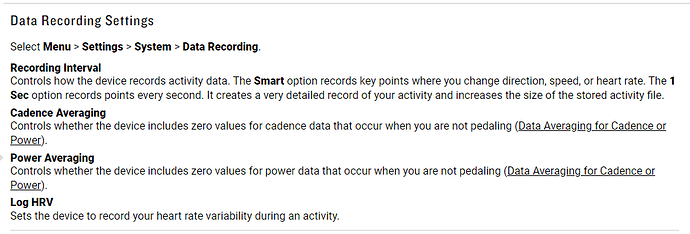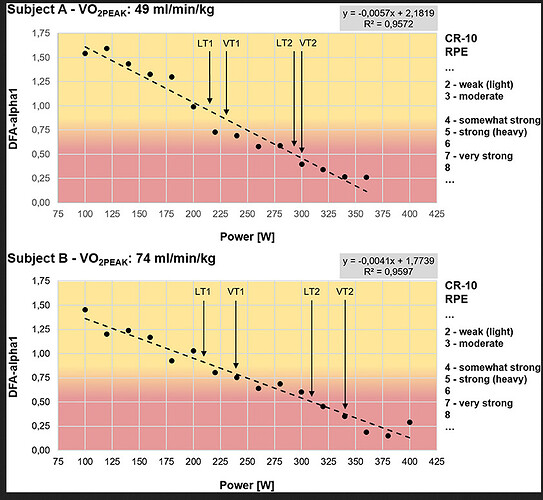I don’t know for sure but a lot of Garmin units can if you apply the file from this post:
I don’t believe this is possible with the native settings on the 20 series, only on the 30 series. For example, I just checked the 520 owners manual online and there is no reference to HRV capability, whereas if I check the 530 owners manual there is reference (as follows):
@MedTechCD solution might work as posted though
Ah yes I remember seeing this a while back, not sure if I got around to trying it, will do so now. Need to brush up on how to get a fit file into ICU rather than relying on a Strava dump, must be fairly simple I guess. Plus I will need to use my head unit indoors which I rarely do being a Trainerroad user. Thanks
OK thanks, I suspect a 520 will be a bit old for this type of thing but I can’t justify the expense of replacing while it is still working fine.
520plus is on the compatibility list of the IQ app.
It can’t hurt to try the fit file, nothing will go wrong. It either reveals the setting or it does nothing.
So what is our current opinion on the best “ramp” protocol to use for assessing DFA-a1?
I follow Bruce Rogers 6 min long intervals and set Fatmaxxer to 5 sec sampling, the risk is starting at too low a power and the session becoming too long
If you do not have a compatible device it wont download and sync
Can you connect through USB and simply drop the fit in NewFiles?
The IQ widget not the file. I did the file thing, currently mid ride to test 
Ah ok. 520 is probably not IQ compatible while 520plus is?
If you applied the fit and the setting “Record HRV” became available, then you should have the RR stream in your activity Fit file. You can check that in Intervals by going to the activity interval data page and downloading the csv streams file. It should have a column titled HRV and values 670:685…
You will not be able to do anything with it right now but when the a1 calculation comes to Intervals, you will have post-ride analysis.
I gave up trying to do this on a ramp protocol. I just started riding (on the trainer) at 60% ftp after a warmup and followed a1 live with Fatmaxxer. Increased bit by bit after getting a somewhat stable value untill a1 was hoovering around 0.75.
Now, when I ride endurance i completely ignore the first 15min because in my case a1 needs about 10-15min before it gets stable and then set resistance to 72% FTP which is usualy close to my VT1 and a1 around 0.8-0.85. Then I adjust resistance accordingly because an endurance ride the day after a VO2max is not the same as after a rest day…
I’m in the minority here, but I think the real-time alpha1 is not very useful. As an athlete, you should get to know how it feels to approach and cross over VT1. Doing low-intensity work is perfect for developing this skill.
The most important thing, if you want to use alpha1, is to get reliable data. And I’m not convince that ConnectIQ app is there yet.
If you already record rr intervals, then you can analyze alpha1 post-ride, for free, with Golden Cheetah and Runalyze. Those two tools have been very reliable and flexible. I prefer Bluetooth over Ant+, but collect rr intervals on Fenix5 and Fenix3, but only really analyze the Fenix5 data. I’ve used Kubios, Artiifact, and tried RHRV and other open-source tools.
If you use the Golden Cheetah script, you get a regression from pace, power, and heart rate. Runalyze does a regression, too and also allows you to export alpha1 to csv for further analyses.
I check alpha1 after every ride and run with a chart based on Marco Altini’s script. I’ve compared alpha1 to blood lactate samples and it seems to work well. But people should read the paper and understand that using 0.75 arbitrarily is not the way to go.
Here’s some of my data:
Correct
Ah, I didn’t look for that. Ah well, finished now so will check the fit file when later.
I absolutely agree that the app isn’t there yet, but it looks promising.
And once more, correct training isn’t done by constantly chasing the higher limits in the idea of “more is better”. I tend to stay away from the limits and leave a “safety/error” zone. So I use 0.8-0.85 as a target for endurance. In the beginning it makes you think that you are waisting your time training that “low” but after a month or 2, you just can’t ignore the positive results.
Thanks. Got it!
How would you know if installing this file has been successful?
Nope, nothing there I’m afraid
which hr monitor?
tks.

